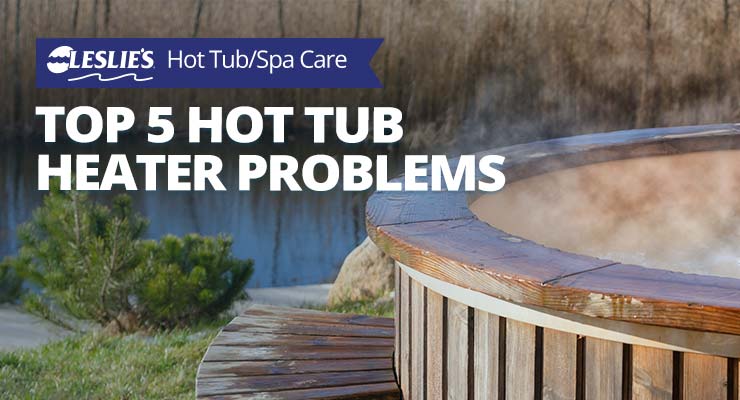
Top 5 Hot Tub Heater Problems
Hot tub won't heat?! A hot tub without heat is, well, COLD! And that makes it a small pool — not at all its intended purpose. Hot tubs are meant to be HOT. If you've ever been in just a warm tub, you know it's just not the same.
If you're in charge of the hot tub at home, you immediately hear the complaints when the hot tub heater is not working properly. It could be the hot tub heater itself, or you may need hot tub replacement parts. One thing is for certain, a quick solution is a must for low heat or no heat in your spa or hot tub.
Below are the top five hot tub heater problems — a list representing the most common reasons why your hot tub may not be kicking out the heat. We also include photos, basic how-to directions, and links to help you fix your issues with various hot tub parts.
1. Low Flow
Sufficient water flow is crucial to keeping your hot tub heater working properly. Low flow in your spa or hot tub is most commonly associated with a dirty spa filter. If your spa heater won't heat, remove and clean the filter(s) to rule out a pressure or flow rate problem. Low water level, a clogged pump impeller, closed valves, clogged pipes, or blocked spa drain covers can also cause flow issues. Some hot tub heaters have screens on the inlet side to trap any debris that gets past the filter. If this becomes clogged, you may notice reduced water flow coming into the spa or hot tub.
Troubleshooting a Faulty Pressure Switch
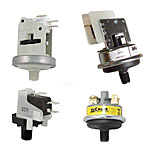
One solution to low water flow is a pressure switch, which is screwed into the heater chamber. It senses when the water pressure is too low, and thus protects the heater against overheating. Pressure switches break the electrical circuit powering the heater element, and the heater shuts down when the water flow is insufficient. It will start heating again once the proper water level and flow are established.
You can test the performance of most pressure switches by using a jumper wire to connect the two wires together, bypassing the switch.
Many spa pressure switches can be adjusted with a thumb wheel or small slotted screw to close the circuit at a particular pressure rating. For example, some are adjustable from 1 to 5 PSI. You can make small adjustments to the pressure switch by turning the wheel or screw, but the factory-calibrated setting is safest for your spa heater.
Troubleshooting a Faulty Flow Switch
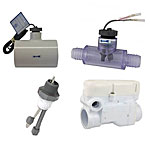
Some spa heaters use a flow switch instead of a pressure switch, or sometimes the two devices in combination. Flow switches are triggered by water flow, not water pressure. When water flow is great enough, two paddles are pushed together to close the circuit. When flow is less than required, the flow switch remains open and the heater will not operate.
You can test the performance of most flow switches by using a jumper wire to connect the two wires together, bypassing the switch. Harwil type mechanical flow switches can also be unscrewed from the tee housing and inspected for scale or corrosion.
Flow switches are not adjustable, but sometimes do need adjustment. Be sure that surfaces are clean and free of scale, and that the paddles are not bent. Harwil type flow switch paddles must also be perpendicular to the water flow for full operation.
2. Thermostat Issues
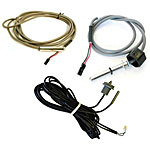
The thermostat is the dial that you turn to crank up the heat. Most new spas use a temp sensor connected to a circuit board, and the topside control panel is just a remote control. Spas of 20 years ago mostly used potentiometers and solid state probes. For spas 30-40 years old, mechanical thermostats with a capillary bulb are common. If you have a thermostat "knob" instead of a lighted red arrow, you can test your thermostat to see if the unit is faulty internally or if the sensor bulb has become corroded.
For newer spas and hot tub heaters with a topside control panel, the thermostat is usually replaced by a temperature sensor. This plugs into the main circuit board on your spa controller, and the probe end slips into a thermowell. Inspect the cord and probe for damage, and be sure that it is plugged into the panel snugly. If your topside control panel is displaying incorrect water temperature, it's likely a bad temp sensor. However, if it's not displaying properly, does not respond to input, or appears to be water damaged, your hot tub heater problems could actually be an issue with the topside control panel.
3. High Limit Switch
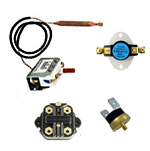
The high limit is another switch, similar to the pressure switch and thermostat discussed above, in that it is part of the safety circuit. Its purpose is to prevent a runaway spa heater – one that won't shut off and could overheat (OH), creating scalding water or causing an entire hot tub meltdown. High limit switches are calibrated with a preset maximum temperature at which the switch will open, breaking the electrical circuit that carries power to your spa heater element.
Some hot tubs use two high limits: one monitoring temperature inside the heater and one outside of the heater. High limit errors will normally display as an HL code or OH code when they are the cause of the heater problem in your hot tub. On older spas, the red button will physically "pop out" from the spa device when the high limit has been reached.
Nuisance high limit tripping on your spa can be related to low water flow (causing higher than normal heater temperature), incorrect voltage, a malfunctioning element, loose wire connections, damaged wires or a faulty high limit switch.
4. Hot Tub Heater Element
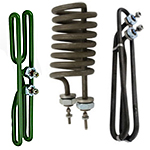
Hot tub heater elements are similar to an electric hot water heater element, and as such, spa heater elements burn out very quickly if operated without cooling water surrounding it. Hot tub heater elements can also be tested to determine if there is a short in the coating surrounding the heating element. Use a test meter set on ohms (Ω) to measure spa heater element resistance. A good element should usually display 9-12 ohms. If it pegs to "infinity," or keeps rising slowly, there is a short in the element and it should be replaced.
Spa heater elements can also develop a scale buildup from hard water or salt water sanitation systems. When a spa element develops scale on the outside of the element, it will reduce the element's heat output, and could eventually lead to element failure. Spa heater elements look like a stovetop heater coil. As such, if the outer casing becomes cracked, a new element is needed. For areas that have hard water, using a sequestering agent (to keep calcium in solution) and running alkalinity on the low side, (70-80 ppm), can reduce scale formation on heater elements.
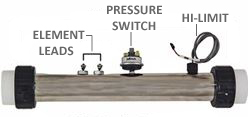
For those of you with newer spas, you'll often find that your spa heater element is housed in a sleek stainless steel chamber, with unions for easy removal. On these complete spa heaters, you can test the element, high limit, and pressure switch for resistance, measured in ohms. When testing with a multimeter or ammeter, an "open" is when the meter spikes to a high reading. A "short" is when there is little to no activity on the meter. When there is no resistance, the current is leaving the circuit, which is also known as a "short circuit."
5. Other Causes of Hot Tub Heater Problems
We saved the best for last. This last category of hot tub heater problems is really the first line of defense when troubleshooting issues. While we list this category last, you may wish to use it as your quick-fix checklist first.
GFCI Tripped
Look for the electrical outlet on your spa pack – the one with the red TEST button. If it's popped out, push it back in firmly.
Door Interlock Open
Many spas have a cabinet switch or spa pack cover switch to prevent operation unless the doors are tightly closed.
Spa Cover Needs Replaced
Warped, broken, and ill-fitting spa covers can allow heat to escape just as quickly as the heater adds it to the water.
Loose Wires
Connections must be tight and not oxidized. Chewed wires (rodents), melted wires, or crimped wires are also possible.
Blown Fuse
A power spike, surge or other incorrect voltage may have destroyed the fuse on a control board.
Happy hot tub maintenance to you all. If you’re having trouble identifying the cause of your hot tub heater problems, check in with the team of experts at Leslie’s. Our trained service staff can help you through just about any hot tub challenge you may face. Stop by your local Leslie’s today!